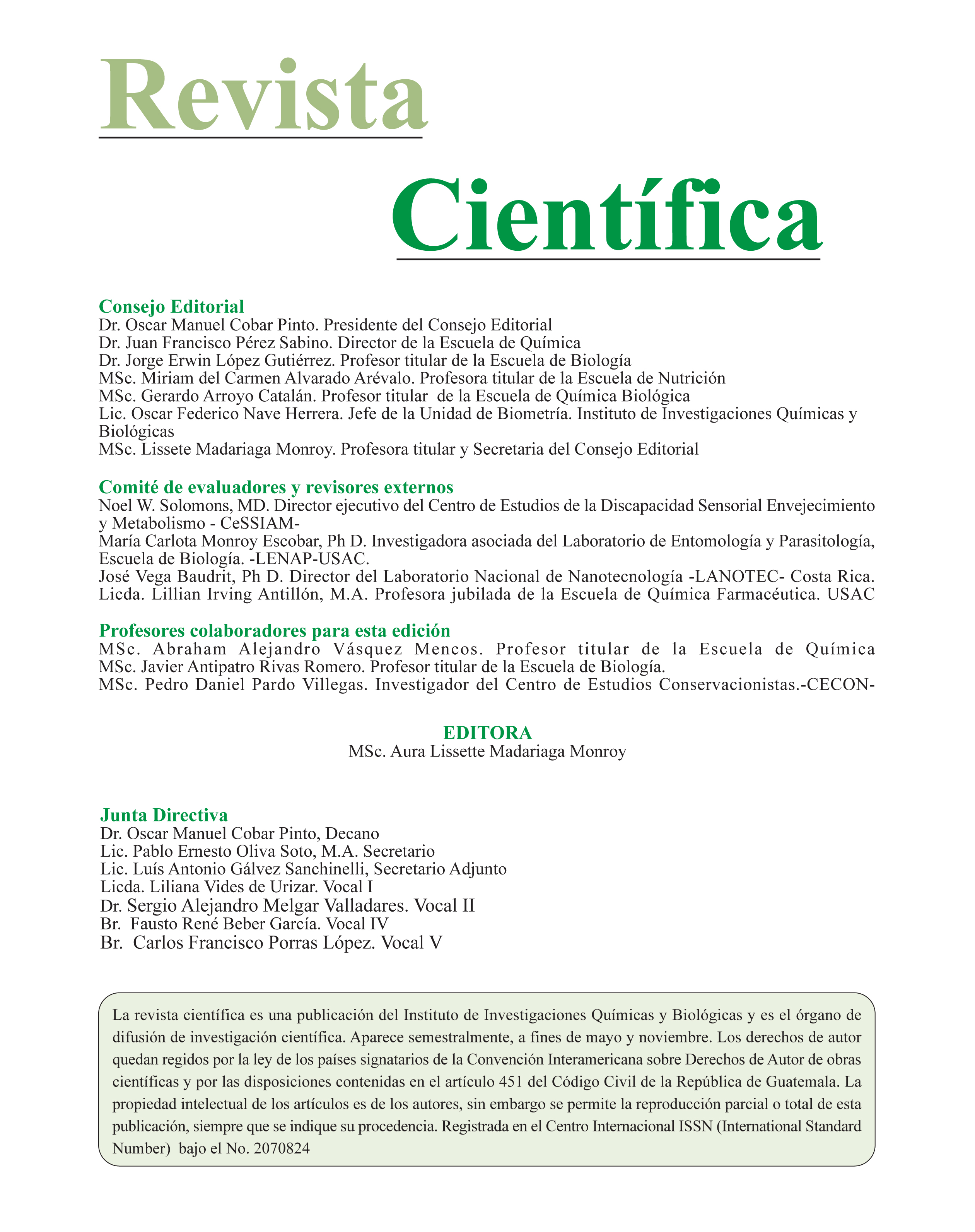Frequency of Helicobacter pylori IgG antibodies in food handlers in the university campus, zone 12
DOI:
https://doi.org/10.54495/Rev.Cientifica.v22i1.119Keywords:
Helicobacter pylori, Symptoms associated, risk factorsAbstract
Helicobacter pylori is a bacterium that affects nearly 60% of the world’s population, it´s considered as the most common cause of chronic active gastritis and it is strongly associated to peptic and duodenal ulcerative disease, playing an important role in ethiopatologic process, for this reason it has been classified as type I carcinogen by the World Health Organization (WHO). The bacterium can be acquired from childhood, and is transmitted fecal - oral, oral - oral, causing specific symptoms that hinder the clinical diagnosis. This study was conducted in 151 food handlers of the campus of the University of San Carlos located at zone 12, in order to determine the frequency of IgG antibodies to H. pylori in this population and then associate symptoms and risk factors with the presence of these antibodies. The results showed a frequency of positivity for IgG antibodies to H. pylori of 72.19% (109/151), of which 69.81% were female and 77.77% male. No association was found with the presence of IgG antibodies to H. pylori and symptoms such as stomach pain, nausea, weight loss, diarrhea, bitter mouth, heartburn, headache and vomiting. As well as between the H. pylori IgG antibodies and risk factors such as overcrowding, salary level, access to safe water and to health services. We conclude that the frequency of IgG antibodies to H. pylori found in food handlers of the study is 72.1 (95% CI = 64.71-79.66%). It is recommended to provide medical services to the retailers positive for IgG antibodies to H. pylori, to help eradicate the infection and thus reduce the risk of contamination to the population using its services.
Downloads
References
Añea, M., Romero,G., Lizarzabal, M., Rangel, R., Serrano, A., Latuff, Z. (2006). Sensilidad y especificadad de las pruebas de ureasa, histología de mucosa gástrica, serología, cultivo y pcr en identificación del Helicobacter pylori. Servicio de gastroenterología. Maracaibo. (Vol. 60, No.2). Venezuela. Revista de la sociedad Venezolana de Gastroenterología.
Organización Mundial de Gastroenterología. Guías prácticas Helicobacter pylori en los países en desarrollo. (Agosto, 2010). Organización Mundial de la Gastroenterología.
Graham, R., Fendrick A., Go, M. Marshall BJ, Peura DA. (1999). Scope and consequences of pepti ulcer disease – How important is Helicobacter pylori infection? Postgrad Med. https://doi.org/10.3810/pgm.1999.03.593 DOI: https://doi.org/10.3810/pgm.1999.03.593
Hall Orantes, H. (2001). Relación de tipos de gastritis diagnosticados por gastroscopías con hallazgos anatopatológicos de H. pylori. Tesis. Facultad de Ciencias Médicas. USAC. Guatemala.
Echeverría J, Estrada C, Garavito E, Girón C, Lange K, Matta V, Monterroso L, Nave F, Quiroz A, Rodas J (2008). Seroprevalencia de Anticuerpos IgM e IgG anti Helicobacter pylori en Catedráticos y Auxiliares de Cátedra de la Facultad de Ciencias Químicas y Farmacia. Revista investigación Integrada. Helicobacter pylori. (Año II, No. 1). Facultad de Ciencias Químicas y Farmacia. USAC. Guatemala.
Chang, J. García, R. Jerez, L., Pérez, V. Polanco, C. Ramírez L. Reyes C. Zelada, G. Lange, K. Nave, F. Matta, V. (2008). Seroprevalencia de anticuerpos IgG e IgM en el Personal Administrativo de Faculta de Ciencias Químicas y Farmacia de la Universidad de San Carlos de Guatemala Revista investigación Integrada. Helicobacter pylori. (Año II, No. I). Facultad de Ciencias Químicas y Farmacia. USAC. Guatemala.
Orengel, S. (2002). Prevalencia de anticuerpos séricos con H. pylori en niños menores de 3 años de baja condición socioeconómica. Tesis Facultad de Ciencias Médicas. USAC. Guatemala.
Downloads
Published
How to Cite
Issue
Section
License
Copyright (c) 2012 G. Cifuentes, Y. Silvestre, K. Lange, V. Matta

This work is licensed under a Creative Commons Attribution 4.0 International License.
Authors who publish with this journal agree to the following terms:
- Authors retain copyright and grant the journal right of first publication with the work simultaneously licensed under a Creative Commons Attribution License 4.0 that allows others to share the work with an acknowledgement of the work's authorship and initial publication in this journal.
- Authors are able to enter into separate, additional contractual arrangements for the non-exclusive distribution of the journal's published version of the work (e.g., post it to an institutional repository or publish it in a book), with an acknowledgement of its initial publication in this journal.
- Authors are permitted and encouraged to post their work online (e.g., in institutional repositories or on their website) prior to and during the submission process, as it can lead to productive exchanges, as well as earlier and greater citation of published work.









